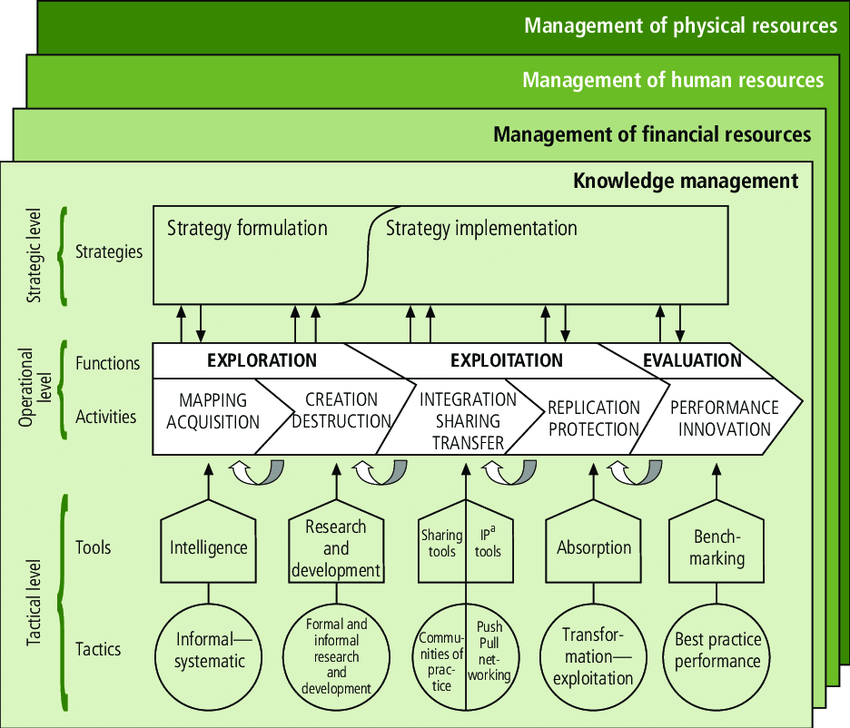- From: carl mattocks <carlmattocks@gmail.com>
- Date: Tue, 22 Sep 2020 13:09:02 -0400
- To: Owen Ambur <Owen.Ambur@verizon.net>, paul alagna <PJAlagna@gmail.com>, W3C AIKR CG <public-aikr@w3.org>
- Message-ID: <CAHtonukvuADa5N-PO76J_CFBGS8xOAtG3Cz+2aDhuxPp5EOpZA@mail.gmail.com>
Regarding our discussion today about schema for 'publishing knowledge (representation)' that would have same multi-level Value Chain based on Strategies & [exploration, exploitation and evaluation].... note: you messaged : The " knowledge-value_chain_A_conceptual_framework " is now available in StratML format at https://stratml.us/drybridge/index.htm#KVC The mission, vision, goals and strategies of a public health organization or social enterprise drive the knowledge-value chain. The higher the knowledge performance related to dyadic capabilities, the higher the value generated (Fig. 1). https://www.researchgate.net/publication/6869769_The_knowledge-value_chain_A_conceptual_framework_for_knowledge_translation_in_health For consideration I also propose that ... to introduce Knowledge (representation) Quality controls we would use Exploration / Exploitation / Evaluation in a matrix cross-checking with Define, measure, analyze, improve, and control (DMAIC) ..a data-driven quality strategy used to improve processes. .. It is an integral part of a Six Sigma <https://asq.org/quality-resources/six-sigma> initiative, but in general can be implemented as a standalone quality improvement procedure or as part of other process improvement initiatives such as lean <https://asq.org/quality-resources/lean>. KRVC/Quality Exploration Exploitation Evaluation Define Measure Analyze Improve Control Define the problem, improvement activity, opportunity for improvement, the project goals, and customer (internal and external) requirements. Project charter to define the focus, scope, direction, and motivation for the improvement team Voice of the customer to understand feedback from current and future customers indicating offerings that satisfy, delight, and dissatisfy them Value stream map to provide an overview of an entire process, starting and finishing at the customer, and analyzing what is required to meet customer needs Measure process performance. Process map for recording the activities performed as part of a process Capability analysis to assess the ability of a process to meet specifications Pareto chart to analyze the frequency of problems or causes Analyze the process to determine root causes of variation and poor performance (defects). Root cause analysis (RCA) to uncover causes Failure mode and effects analysis (FMEA) for identifying possible product, service, and process failures Multi-vari chart to detect different types of variation within a process Improve process performance by addressing and eliminating the root causes. Design of experiments (DOE) to solve problems from complex processes or systems where there are many factors influencing the outcome and where it is impossible to isolate one factor or variable from the others Kaizen event to introduce rapid change by focusing on a narrow project and using the ideas and motivation of the people who do the work Control the improved process and future process performance. Quality control plan to document what is needed to keep an improved process at its current level Statistical process control (SPC) for monitoring process behavior *Balanced Scoring* (my edit) to create a workplace suited for visual control Mistake proofing (poka-yoke) to make errors impossible or immediately detectable cheers Carl It was a pleasure to clarify ---------- Forwarded message --------- From: carl mattocks <carlmattocks@gmail.com> Date: Wed, Sep 2, 2020 at 10:02 AM Subject: Re: AIKR Value Chain To: W3C AIKR CG <public-aikr@w3.org> Cc: Paola Di Maio <paoladimaio10@gmail.com>, Chris Fox <chris@chriscfox.com>, Paul Alagna <pjalagna@gmail.com>, Justin Stoltzfus <stoltz_sj@hotmail.com>, Jorge Sanchez. <jorgesr@zoho.eu>, Owen Ambur <Owen.Ambur@verizon.net> Confirming that the AI KR value chain will be the focus of our next meeting on September 15 (invite to be sent separately). In addition to ITIF's model (see below), as a use-case please review The knowledge-value chain: A conceptual framework for knowledge translation in health ( Bulletin of the World Health Organisation ). In particular, please peruse fig1. The mission, vision, goals and strategies of a public health organization or social enterprise drive the knowledge-value chain. The higher the knowledge performance related to dyadic capabilities, the higher the value generated (Fig. 1). https://www.researchgate.net/publication/6869769_The_knowledge-value_chain_A_conceptual_framework_for_knowledge_translation_in_health have a great weekend Carl Mattocks co-chair AIKRCG It was a pleasure to clarify On Tue, Sep 1, 2020 at 4:30 PM Owen Ambur <Owen.Ambur@verizon.net> wrote: > Carl, at the end of our televideo conference earlier today you indicated > intent to focus on the value chain at our next meeting on September 15. So > I thought you might like to see this objective in ITIF's model for > long-term U.S./Western revitalization (in competition with China): > > ........... > >
Attachments
- image/png attachment: The-knowledge-value-chain.png

Received on Tuesday, 22 September 2020 17:09:55 UTC